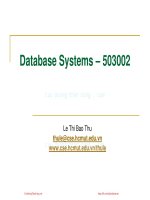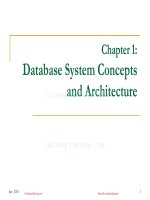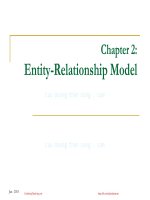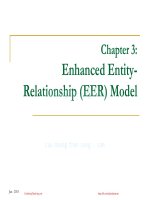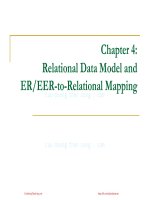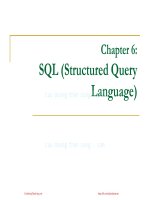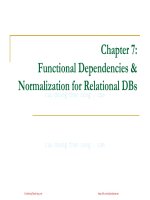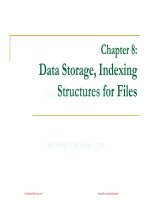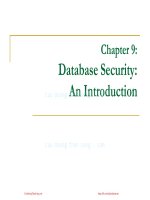cơ sở dữ liệu lê thị bảo thu chương ter 10 emerging database technologies applications sinhvienzone com
Bạn đang xem bản rút gọn của tài liệu. Xem và tải ngay bản đầy đủ của tài liệu tại đây (1.52 MB, 87 trang )
Chapter 10:
Emerging Database
Technologies & Applications
CuuDuongThanCong.com
/>
1
Contents
1
Distributed Databases & Client-Server Architectures
2
Spatial and Temporal Database
3
Multimedia Databases
4
Geographic Information Systems
5
XML
6
Data Warehousing
7
Outsourcing database services
8
Big Data
CuuDuongThanCong.com
/>
2
Contents
1
Distributed Databases & Client-Server Architectures
2
Spatial and Temporal Database
3
Multimedia Databases
4
Geographic Information Systems
5
XML
6
Data Warehousing
7
Outsourcing database services
8
Big Data
CuuDuongThanCong.com
/>
3
Distributed Databases &
Client-Server Architectures
Distributed Database Concepts
Data Fragmentation, Replication and
Allocation
3-Tier Client-Server Architecture
CuuDuongThanCong.com
/>
4
Distributed Database Concepts
A transaction can be executed by multiple
networked computers in a unified manner.
A distributed database (DDB) processes a unit
of execution (a transaction) in a distributed
manner.
DDB is a collection of multiple logically related
database distributed over a computer network,
and a distributed database management system
as a software system that manages a distributed
database while making the distribution
transparent to the user.
CuuDuongThanCong.com
/>
5
Distributed Database System
CuuDuongThanCong.com
/>
6
Distributed Database System
CuuDuongThanCong.com
/>
7
Distributed Database System
Types of Transparency:
Data organization transparency (Distribution
and Network transparency)
Users do not have to worry about operational details of
the network.
Location transparency refers to freedom of issuing
command from any location without affecting its working.
Naming transparency allows access to any names
object (files, relations, etc.) from any location.
CuuDuongThanCong.com
/>
8
Distributed Database System
Types of Transparency:
Replication transparency:
It allows to store copies of a data at multiple sites.
It minimizes access time to the required data.
Fragmentation transparency:
Allows to fragment a relation horizontally (create a
subset of tuples of a relation) or vertically (create a
subset of columns of a relation).
CuuDuongThanCong.com
/>
9
Distributed Database System
Types of Transparency:
Design transparency:
Refer to freedom from knowing how the distributed
database is designed
Execution transparency:
Refer to freedom from knowing where a transaction
executes
CuuDuongThanCong.com
/>
10
Distributed Database System
Advantages of Distributed Database System
Improved ease and flexibility of application
development
Developing and maintaining applications at
geographically distributed sites of an organization is
facilitated owing to transparency of data distribution and
control.
CuuDuongThanCong.com
/>
11
Distributed Database System
Advantages of Distributed Database System
Increased reliability and availability:
Reliability refers to system live time, that is, system is
running efficiently most of the time. Availability is the
probability that the system is continuously available
(usable or accessible) during a time interval.
A distributed database system has multiple nodes
(computers) and if one fails then others are available to
do the job.
CuuDuongThanCong.com
/>
12
Distributed Database System
Advantages of Distributed Database System
Improved performance:
A distributed DBMS fragments the database to keep
data closer to where it is needed most.
This reduces data management (access and
modification) time significantly.
Easier expansion (scalability):
Allows new nodes (computers) to be added anytime
without chaining the entire configuration.
CuuDuongThanCong.com
/>
13
Data Fragmentation, Replication and
Allocation
Data Fragmentation
Split a relation into logically related and correct
parts. A relation can be fragmented in two ways:
Horizontal Fragmentation: It is a horizontal subset of a
relation which contain those of tuples which satisfy
selection conditions
Vertical Fragmentation: It is a subset of a relation
which is created by a subset of columns.
CuuDuongThanCong.com
/>
14
Data Fragmentation, Replication and
Allocation
Fragmentation schema
A definition of a set of fragments (horizontal or vertical or
horizontal and vertical) that includes all attributes and
tuples in the database that satisfies the condition that the
whole database can be reconstructed from the fragments
by applying some sequence of UNION (or OUTER JOIN)
and UNION operations.
Allocation schema
It describes the distribution of fragments to sites of
distributed databases. It can be fully or partially replicated
or can be partitioned.
CuuDuongThanCong.com
/>
15
Data Fragmentation, Replication and
Allocation
Data Replication
Database is replicated to all sites.
In full replication the entire database is replicated and in
partial replication some selected part is replicated to some
of the sites.
Data replication is achieved through a replication schema.
Data Distribution (Data Allocation)
This is relevant only in the case of partial replication or
partition.
The selected portion of the database is distributed to the
database sites.
CuuDuongThanCong.com
/>
16
Client-Server Database Architecture
It consists of clients running client software, a set of
servers which provide all database functionalities
and a reliable communication infrastructure.
Server 1
Client 1
Client 2
Server 2
Client 3
Server n
Client n
CuuDuongThanCong.com
/>
17
Client-Server Database Architecture
Clients reach server for desired service, but
server does reach clients.
The server software is responsible for local
data management at a site, much like
centralized DBMS software.
The client software is responsible for most of
the distribution function.
The communication software manages
communication among clients and servers.
CuuDuongThanCong.com
/>
18
Client-Server Database Architecture
The processing of a SQL queries goes as
follows:
Client parses a user query and decomposes it into
a number of independent sub-queries. Each
subquery is sent to appropriate site for execution.
Each server processes its query and sends the
result to the client.
The client combines the results of subqueries and
produces the final result.
CuuDuongThanCong.com
/>
19
Contents
1
Distributed Databases & Client-Server Architectures
2
Spatial and Temporal Database
3
Multimedia Databases
4
Geographic Information Systems
5
XML
6
Data Warehousing
7
Outsourcing database services
8
Big Data
CuuDuongThanCong.com
/>
20
Temporal Database Concepts
Time Representation
Calendars
Time Dimensions
CuuDuongThanCong.com
/>
21
Temporal Database Concepts
Time Representation
Time is considered ordered sequence of points in
some granularity
Use the term chronon instead of point to describe
minimum granularity
A calendar organizes time into different time units
for convenience.
Accommodates various calendars
Gregorian (western), Chinese, Islamic, Hindu, etc.
CuuDuongThanCong.com
/>
22
Temporal Database Concepts
Time Representation
Point events
Single time point event
E.g., bank deposit
Series of point events can form a time series data
Duration events
Associated with specific time period
Time period is represented by start time and end time
CuuDuongThanCong.com
/>
23
Temporal Database Concepts
Time Representation
Transaction time
The time when the information from a certain transaction
becomes valid
Bitemporal database
Databases dealing with two time dimensions
CuuDuongThanCong.com
/>
24
Temporal Database Concepts
Incorporating Time in Relational Databases
Using Tuple Versioning
Add to every tuple
Valid start time
Valid end time
CuuDuongThanCong.com
/>
25
